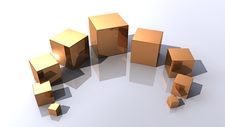Non-Standard Measurements

TEKS Objective
The student is expected to collect data and make observations using simple equipment such as hand lenses, primary balances, and non-standard measurement tools.
Essential Understanding
The student develops abilities to ask questions and seek answers in classroom and outdoor investigations.
Science Background
Measurement Standard for Grades Pre-K-2: National Council of Teachers of Mathematics (website) - Explains fundamental concepts, skills and techniques of measurement—including the use of non-standard tools—for early childhood grades.
Measurement Standard for Grades Pre-K-2
National Council of Teachers of Mathematics, www.nctm.org
Signature Lesson
The Length of My Feet: NCTM Illuminations (website) - Students learn about and employ nonstandard tools to collect data, observe and measure the length, size and/or distance of different items. They also learn that length is a measurable attribute of objects.
The Length of My Feet
NCTM Illuminations, illuminations.nctm.org
Magnificent Measurement, The Weight of Things: NCTM Illuminations (website) - Introduce students to nonstandard units with which to measure weight. Students make observations and predict the weights of different objects, arrange the objects from lightest to heaviest, and use scales to collect data and determine the accuracy of their estimates.
Magnificent Measurement, The Weight of Things
NCTM Illuminations, illuminations.nctm.org
- Supporting Lessons
- Extensions
- Assessment Ideas
- Literature Connections
- Related
TEKS - Additional Resources
Supporting Lessons
How Many Steps? NCTM Illuminations (website) - To increase their understanding of measurement and statistics, students use non-standard units measure to distances and record their measurements in a bar graph.
How Many Steps?
NCTM Illuminations, illuminations.nctm.org
What Balances It? National Core Knowledge Colorado (PDF) - Students use a balance to compare the weights of different objects. The activity (Lesson Six) is on page 8.
What Balances It?
National Core Knowledge Colorado, www.coreknowledge.org
Measuring Capacity in Cups: National Core Knowledge Colorado (PDF) - Students use cups to estimate and measure the capacity of different containers. Find the activity (Lesson Eight) at the bottom of page 10.
Measuring Capacity in Cups
National Core Knowledge Colorado, www.coreknowledge.org
Elaboration Lessons and Extensions
Exploration of a Balance: NCTM Illuminations (website) - Students balance pairs of like and unlike objects by changing the objects’ distance from the fulcrum. (A crayon serves as the fulcrum and a ruler represents the balance.)
Exploration of a Balance
NCTM Illuminations, illuminations.nctm.org
Assessment Ideas
Give each student several paper clips and a long pencil. Have students estimate the length of the pencil, and then use the paper clips to find the actual measurement. Students should record their estimates and results in their notebooks.
Give each student a rock, a double pan balance and centimeter cubes. Have students predict the mass of the rock then test their prediction using the cubes and balance. They should record their predictions and findings in their notebooks.
Literature Connections
Super Sand Castle Saturday. Murphy, Stuart (ISBN-13: 978-0064467209)
Measurement. Dowdy, Penny (ISBN-13: 978-0778743590)
Capacity. Pluckrose, Henry (ISBN-13: 978-0516454511)
Drip, Drop. Weeks, Sarah (ISBN: 13: 978-0064435970)
Length. Pluckrose, Henry (ISBN-13: 978-0516454535)
Additional Resources
Fill it to Capacity: Utah Education Network (website) - This lesson is written for older learners but can easily be adapted for 1st graders. Use non-standard units and model how to estimate the amount different containers will hold.
Fill it to Capacity
Utah Education Network, www.uen.org
Measuring Fun: National Core Knowledge Colorado (PDF) - Students read and learn about the history of non-standard units and how we developed the standard tools in use today. Through hands on experiments, games, and riddles, students learn how to use rulers, scales, measuring cups, thermometers, and clocks.
Measuring Fun
National Core Knowledge Colorado, www.ckcolorado.org
TEKS Navigation
Grade 1
Need Assistance?
If you need help or have a question please use the links below to help resolve your problem.

Comments